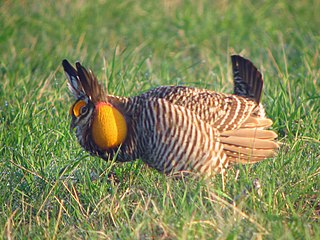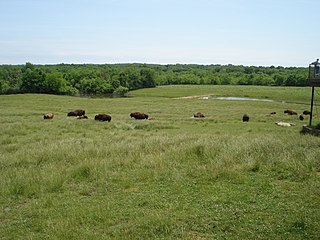
Gary Edward "Garrison" Keillor is an American author, storyteller, humorist, voice actor, and radio personality. He is best known as the creator of the Minnesota Public Radio (MPR) show A Prairie Home Companion, which he hosted from 1974 to 2016. Keillor created the fictional Minnesota town Lake Wobegon, the setting of many of his books, including Lake Wobegon Days and Leaving Home: A Collection of Lake Wobegon Stories. Other creations include Guy Noir, a detective voiced by Keillor who appeared in A Prairie Home Companion comic skits. Keillor is also the creator of the five-minute daily radio/podcast program The Writer's Almanac, which pairs one or two poems of his choice with a script about important literary, historical, and scientific events that coincided with that date in history.

Prairie dogs are herbivorous burrowing rodents native to the grasslands of North America. The five species are: black-tailed, white-tailed, Gunnison's, Utah, and Mexican prairie dogs. They are a type of ground squirrel, found in North America. In Mexico, prairie dogs are found primarily in the northern states, which lie at the southern end of the Great Plains: northeastern Sonora, north and northeastern Chihuahua, northern Coahuila, northern Nuevo León, and northern Tamaulipas. In the United States, they range primarily to the west of the Mississippi River, though they have also been introduced in a few eastern locales. They are also found in the Canadian Prairies. Despite the name, they are not actually canines.

In physical geography, a steppe is an ecoregion characterized by grassland plains without trees apart from those near rivers and lakes. Steppe biomes may include:

Prairies are ecosystems considered part of the temperate grasslands, savannas, and shrublands biome by ecologists, based on similar temperate climates, moderate rainfall, and a composition of grasses, herbs, and shrubs, rather than trees, as the dominant vegetation type. Temperate grassland regions include the Pampas of Argentina, Brazil and Uruguay, and the steppe of Ukraine, Russia and Kazakhstan. Lands typically referred to as "prairie" tend to be in North America. The term encompasses the area referred to as the Interior Lowlands of Canada, the United States, and Mexico, which includes all of the Great Plains as well as the wetter, hillier land to the east.

Laura Elizabeth Ingalls Wilder was an American writer known for the Little House on the Prairie series of children's books, published between 1932 and 1943, which were based on her childhood in a settler and pioneer family.

Grasslands are areas where the vegetation is dominated by grasses (Poaceae); however, sedge (Cyperaceae) and rush (Juncaceae) families can also be found along with variable proportions of legumes, like clover, and other herbs. Grasslands occur naturally on all continents except Antarctica. Grasslands are found in most ecoregions of the Earth. For example, there are five terrestrial ecoregion classifications (subdivisions) of the temperate grasslands, savannas, and shrublands biome (ecosystem).

Sun Prairie is a city in Dane County in the U.S. state of Wisconsin. A suburb of Madison, it is part of the Madison Metropolitan Statistical Area. The city's population was 29,441 at the 2010 U.S. Census. It is the second-most populous city in Dane County after Madison.

The greater prairie chicken or pinnated grouse, sometimes called a boomer, is a large bird in the grouse family. This North American species was once abundant, but has become extremely rare and extirpated over much of its range due to hunting and habitat loss. Conservation measures are underway to ensure the sustainability of existing small populations. One of the most famous aspects of these creatures is the mating ritual called booming.

Grande Prairie is a city in northwest Alberta, Canada within the southern portion of an area known as Peace River Country. It is located at the intersection of Highway 43 and Highway 40, approximately 456 km (283 mi) northwest of Edmonton. The city is surrounded by the County of Grande Prairie No. 1.

Prairie Public is a network of ten North Dakota radio stations. It is a service of Prairie Public Broadcasting, in association with the North Dakota State University in Fargo and the University of North Dakota (UND) in Grand Forks.

The prairie warbler is a small songbird of the New World warbler family.

Pure Prairie League is an American country rock band whose origins go back to 1965 and Waverly, Ohio, with singer and guitarist Craig Fuller, drummer Tom McGrail, guitarist and drummer Jim Caughlan and steel guitar artist John David Call. Fuller started the band in 1970 and McGrail named it after a fictional 19th century temperance union featured in the 1939 Errol Flynn cowboy film Dodge City. Pure Prairie League scored five consecutive Top 40 LPs in the 1970s and added a sixth in the 1980s. The band has had a long run, active from the early 1970s through the late 1980s. The band was revived in 1998 and again in 2004 and as of 2019 continues to perform over 100 concerts a year in venues across the nation. Concerts for 2020 have already been booked.

Portage la Prairie is a small city in the Central Plains Region of Manitoba, Canada. As of 2016, the population was 13,304 and the land area of the city was 24.68 square kilometres (9.53 sq mi). Portage la Prairie is approximately 75 kilometres (47 mi) west of Winnipeg, along the Trans-Canada Highway, and sits on the Assiniboine River, which flooded the town persistently until a diversion channel north to Lake Manitoba was built to divert the flood waters. The city is surrounded by the Rural Municipality of Portage la Prairie.

Prairie School is a late 19th- and early 20th-century architectural style, most common in the Midwestern United States. The style is usually marked by horizontal lines, flat or hipped roofs with broad overhanging eaves, windows grouped in horizontal bands, integration with the landscape, solid construction, craftsmanship, and discipline in the use of ornament. Horizontal lines were thought to evoke and relate to the wide, flat, treeless expanses of America's native prairie landscape.

Wildlife Prairie Park, officially dedicated as Hazel & Bill Rutherford Wildlife Prairie Park, is located in Peoria County, Illinois, in central Illinois, about 10 miles (16 km) west of downtown Peoria. The park contains wildlife animals native to Illinois, in a natural environment.

The black-tailed prairie dog is a rodent of the family Sciuridae found in the Great Plains of North America from about the United States-Canada border to the United States-Mexico border. Unlike some other prairie dogs, these animals do not truly hibernate. The black-tailed prairie dog can be seen above ground in midwinter. A black-tailed prairie dog town in Texas was reported to cover 25,000 sq mi (64,000 km2) and included 400,000,000 individuals. Prior to habitat destruction, this species may have been the most abundant prairie dog in central North America. This species was one of two described by the Lewis and Clark Expedition in the journals and diaries of their expedition.

The Bloomington PrairieThunder were a minor league professional ice hockey team based in Bloomington, Illinois. They were a member of the Central Hockey League in the Turner Conference. The team was originally a member of the United Hockey League prior to its merger into the CHL in 2010. They played their home games at the U.S. Cellular Coliseum.

A shooter, or shot, is a small serving of spirits or a mixed drink, or also known as a culinary art. typically consumed quickly, always in a single gulp. It is common to serve a shooter as a "side" to a larger drink.

The Osage Plains are a physiographic section of the larger Central Lowland province, which in turn is part of the larger Interior Plains physiographic division. The area is sometimes called the Lower Plains, North Central Plains,or Rolling Plains. The Osage Plains, covering west-central Missouri, the southeastern third of Kansas, most of central Oklahoma, and extending into north-central Texas, is the southernmost of three tallgrass prairie physiographic areas. It grades into savanna and woodland to the east and south, and into shorter, mixed-grass prairie to the west. The Osage Plains consist of three subregions. The Osage Plains proper occupy the northeast segment. Although sharply demarcated from the Ozark uplift, the plains are nonetheless a transitional area across which the boundary between prairie and woodland has shifted over time. In the central portion of the physiographic area lies the second subregion, the Flint Hills, commonly called "the Osage" in Oklahoma. This large remnant core of native tallgrass prairie is a rocky rolling terrain that runs from north to south across Kansas and extends into Oklahoma. To the west and south of these hills are the Blackland Prairies and Cross Timbers. This vegetatively complex region of intermixed prairie and scrubby juniper-mesquite woodland extends into north-central Texas. Bluestem prairies and oak-dominated savannas and woodlands characterize the natural vegetation in the Cross Timbers. Much of the area has been converted to agriculture, although expanses of oak forest and woodland are still scattered throughout the eastern portion of the subregion.

Rocky Prairie is a prairie that is about 90 kilometers southwest of Seattle, Washington, United States, and about 15 kilometers south of Washington's capital city of Olympia. It sits very close to the Millersylvania State Park, the community of Maytown, and the city of Tenino.


















